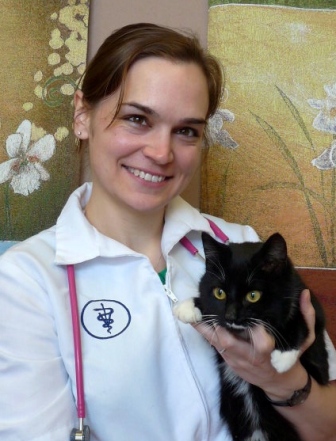Most people know that outdoor cats are at risk for picking up fleas - especially those cats that like to lounge in the shade under bushes where other animals spend their time. But, did you know that even indoor cats can get fleas?
Sometimes, the fleas are brought into the house by unsuspecting owners, on pants legs, on shoes, or other outdoor items. Most times, it is not the adult flea that comes inside. They have a large warm food source, already, why would they want to jump off into the great unknown and leave a good thing behind? Instead, the female flea is almost constantly laying eggs, which roll off the host - a rabbit, a squirrel, a stray cat - and into the dirt. There, the eggs can hatch, and the flea larvae can eat and grow under the bush until it is time to
 |
| Flea larvae are only a little thicker than a cat hair. Under the microscope, we can see this larva has eaten some flea dirt (adult flea feces - digested blood) which gives it a reddish color. |
form the pupal cocoon. Once the pupa stage is reached, the flea is pretty much indestructible. No amount of pesticide is going to hurt that cocoon. After a period of time, that cocoons can be picked up by a human and transported inside. Once inside, when conditions are right, the adult fleas hatch and find a food source - your pampered indoor pet.
Other ways that an indoor cat can get fleas is from visitors to the home - with or without their own pets. We often find out that just before a cat starts scratching, Aunt Sally might have visited along with her Jack Russell Terrier, or maybe the kids just got home from visiting Grandpa Frank and his indoor/outdoor cat Puma. Or, maybe everyone just got back from camping in the Blue Ridge Mountains and the cats were rolling around in the luggage.
Sometimes, your cat will show signs of itchiness such as scratching or excessive grooming if he or she is bothered by the fleas. In cases where cats actually have an allergy to flea saliva, cats will develop hair loss and/or sores in a classic pattern - usually around the base of the tail and the neck. Other signs of fleas are more subtle. Your cat may be noticeably spending more time up off the floor, may be more easily irritated than usual or may have no signs of discomfort at all.
To check for fleas, use a fine-toothed comb and comb your cat from neck to tail, concentrating under the chin and near the base of the tail. Afterwards, check the comb for fleas or flea dirt. If you find a flea, you win! Well, not really, but at least you will know that your cat has fleas. Unfortunately, because cats are such good groomers, just because you don't find fleas, it doesn't mean they're not there. Sometimes, it can be very difficult to catch them in a flea comb - they're fast, and they're flat, and they know how to hide!
 |
| A cat flea caught in a flea comb. Look fast - he's going to jump! |
Flea dirt is another indicator of the presence of fleas. Flea dirt, or flea feces, can be recognized as tiny black specks about the thickness of a hair, often curved, that turn red when water is added and they are rubbed on a white towel. If you find flea dirt, you have fleas, even if you don't find the naughty critter himself. If a flea has been on your cat long enough to produce flea dirt, he's been there a while! If you find a flea but no dirt, then it's likely the flea hasn't been around long.
 |
| The flea life cycle |
The best way to be certain that fleas never enter your home is to make sure that your cat is receiving a monthly flea prevention medication along with his or her heartworm prevention. We usually recommend the all-in-one product
Revolution because it also prevents heartworm infections and has some additional effectiveness against ear and skin mites, ticks and some intestinal parasites.
Advantage Multi is another good topical product that is similar. However, if your cat is already taking Heartgard heartworm prevention, you may want to choose
Frontline or
Advantage instead.
If you already have noticed a flea problem, make sure to read our tips on
fighting fleas. It is important to
remember that if you see adults fleas on your cat, you are only seeing 5% of the problem, so one application of flea preventive is never enough to solve the problem. Your best weapons against fleas are prevention and patience.











